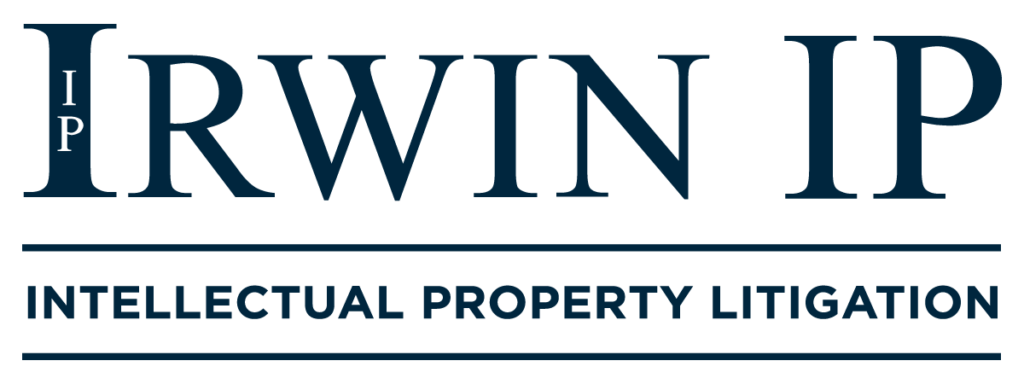
In IBM Corp. v. Zillow Group, Inc., the Federal Circuit affirmed a district court decision dismissing IBM’s patent infringement suit despite an alleged claim construction dispute, which district courts are required to resolve (or affirmatively adopt the non-movant’s construction). IBM asserted that Zillow infringed two of its patents directed at displaying search results to users, and Zillow moved to dismiss the complaint under Federal Rule of Civil Procedure 12(b)(6) arguing that the claims were directed to ineligible subject matter under 35 U.S.C. § 101.
Zillow argued that the patents were ineligible because they were directed toward an abstract idea: a method of displaying search results that improved only user experience (as opposed to actual technological improvements). IBM argued that there was a claim construction dispute in front of the district court that precluded granting a Rule 12 motion. Specifically, IBM argued that the patent claimed a method that utilized a “user context vector” that allowed the system to “improve in its ability to serve individual needs and evolve to an ability to suggest preferred answers to groups of users.” Zillow did not provide an alternative construction to IBM’s proposed construction and stated that it “embraced” IBM’s construction. Because of that, the district court found there was no claim construction dispute to resolve. The Federal Circuit agreed and affirmed the finding that the patents were invalid under Section 101.
Judge Stoll dissented from the Federal Circuit opinion, however, arguing that if the majority actually applied IBM’s proposed claim construction (as opposed to merely taking Zillow’s word for it), it would have found that IBM’s proposed claim construction would have affected the patent eligibility analysis under Section 101. She noted that the district court (and the majority) viewed the claims as having a different scope than IBM. Thus, the district court erred by taking Zillow’s word that there was no dispute instead of analyzing or adopting IBM’s proposed construction. This error was prejudicial, Judge Stoll contends, because “IBM ha[d] demonstrated that its claims plausibly recite an inventive concept under its proposed construction.” The majority addressed Judge Stoll’s dissent in a footnote, explaining that even if the district court erred, it was a harmless error because the underlying concept of the claims merely encompasses the abstract idea of displaying and manipulating data.
This case serves as a cautionary tale when addressing a Section 101 issue early in a matter. Simply alleging that there are claim construction issues, by itself, will likely not be sufficient to avoid dismissal under Rule 12. A patentee needs to provide additional detail as to how its proposed claim construction would result in a favorable Section 101 analysis when opposing a motion to dismiss. A challenger, despite Zillow’s ability to merely state it “embraced” the patentee’s claim construction here, may want to heed Judge Stoll’s dissent and be prepared to explain why adopting a patentee’s claim construction (if the patentee does raise that issue) would not affect a Section 101 argument brought on a Rule 12 motion, rather than merely stated in a conclusory fashion that they have adopted it.
We are through the first month of 2024, and if you are anything like us, you are already questioning the overly ambitious nature of your personal New Year’s resolutions. What seemed doable in the wee hours of December 31st – Eat 60 grams of lean protein a day! Stop eating processed sugar! Keep a gratitude journal! – seems a bit more daunting in the grey light of a ceaseless Chicago slush storm. But hope springs eternal, and if we can’t quite step away from the cinnamon rolls, we can hopefully aid you in getting your trademarks in shape this year. Here are our top ten reminders for trademark owners as we move into 2024:
- Know Your Marks, Past and Present: Do you maintain a single record of all company trademarks, or do you have to click through multiple files in various locations to review your trademark portfolio? Hopefully, not the latter, but regardless, it is a good idea to keep a summary of your trademarks and to audit your products and services at the start of each year to understand the marks your business is no longer using as well as the marks it is using and does want to protect both in the United States and abroad. Depending on the size of your trademark portfolio, this can be a simple bullet point list, or it might require a spreadsheet with multiple tabs. The record should note which of the marks are registered or pending, the goods/services the mark is used in connection with, and any other pertinent information. Trademark counsel can maintain this record with or for you.
- Licenses: If you are a party to any licenses, as either the licensor or the licensee, hopefully you maintain a record of them similar to the record of all company trademarks. If not, it is time to create that record, and it should include the renewal or end dates for each license as well as royalty rates and due dates. If you are the licensor, you should also have counsel perform a quality control check of the terms of the license to avoid claims of naked licensing that may result in an abandonment of your rights.
- Accuracy at the United States Patent and Trademark Office: Did your company recently reorganize? Did it transition from an LLP or an LLC or incorporate in a different state? Make sure to double check that the United States Patent and Trademark Office (USPTO) lists the correct owner of your marks. You may need to file assignments to keep the chain of title correct. Similarly, did you hire a new prosecution attorney? Make sure the correct attorney of record is on file with the USPTO.
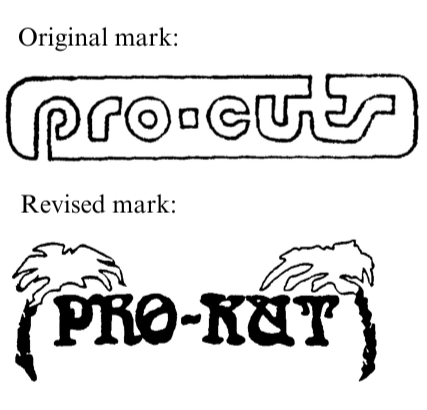
- Brand Drift: Once you have assembled or reviewed/revised your 2024 list of trademarks, it is time to hit the internet and see if your current marks are actually what you think they are. What does this mean? Sometimes your marketing team or web designer might alter your logo or shorten your trademark. Although minor variations of trademarks can “tack” onto prior versions for continued protection, changes that are more than minor might require new trademark applications altogether and may result in an abandonment of your old mark. For example, a mark owner abandoned the mark “Americana” by only using “Americana at Manhasset, and another mark owner could not tack onto an old mark as the revised mark was too different.
- Ad Words and Other Infringers: While you are online, check for infringers. If you search your trademarks online, what results do you get? Has anyone started using your marks without permission in their ad text? Has someone started to use your mark without permission on their own or on a third-party website? Consider hiring a trademark search company to search your key marks or even to implement a monthly or quarterly watch service that will search your key marks and locate infringers. Budget is obviously a consideration here, and it may be that your key marks are the ones to search with a third party, while other marks can be searched in-house. Note that social media platforms should be included in any search for infringers.
- Cybersquatters: If you do conduct a third-party search or initiate a watch notice, you will learn if anyone has registered your marks as domain names. There are more than 1500 top level domains, and it would be too costly to search them all, but even without a third-party search company, the most common top level domains should be checked. If they are available, register them. If they are not, and someone else has them, consider whether you can bring a Uniform Domain Name Dispute Resolution (UDRP), which is a relatively quick and inexpensive way to enforce and protect your brand by initiating an action to cancel, suspend, or transfer an infringing domain name.
- Third Party Protections: If you sell products online and have a pending or registered trademark for your business, register that trademark with the Amazon brand registry. Having your trademark registered with Amazon allows Amazon to identify and stop infringing listings on its platform. If counterfeiting is an issue in your industry, register your marks with the U.S. Customs and Border Protection (CBP). Recording your trademark with CBP permits CBP to detain and seize imported goods if they appear to violate the recorded trademark.
- Marks On the Horizon: Chances are, your marketing department has ideas for 2024, and those ideas likely include new trademarks or twists on current trademarks. Schedule a meeting with the marketing team to see what they have in the works. Get involved sooner rather than later in the process of brand selection, conduct searches to confirm the name or something similar is not being used by others, and avoid infringing prior users. Consider whether to file Intent to Use (ITU) applications and whether any nontraditional trademarks (color, sound, trade dress) may warrant protection too.
- Trademarks 101: It is a good idea to hold a yearly “Trademarks 101” session with your marketing department to educate them on trademark best practices. This session should cover everything from what a trademark is, to when to use a ® or a ™ symbol, to whether and when you can mention another company’s trademark in ads or online.
- Brand Guidelines: Similarly, the start of the new year is a good time to review (or draft for the first time) your brand guidelines. Make sure to include links to the company’s approved logos, colors, sizing, font, and instructions as to how to use a mark properly and consistently. Brand guidelines will be covered in your Trademarks 101, but having the guidelines accessible throughout the year is important as well.
Irwin IP trademark attorneys are here to help you protect your marks. Please contact us if you have any questions about or need help making 2024 a “Brand” New Year.
In the most recent of three Copyright Review Board decisions regarding artificial intelligence (“AI”) works, the Board once again found that an artistic work generated by inputting the author’s photograph of a sunset and Van Gogh’s The Starry Night, into the RAGHAV AI Painting App, then selecting the intensity of a style filter did not constitute more than de minimis creative human expression, preventing the work from achieving copyright protection.
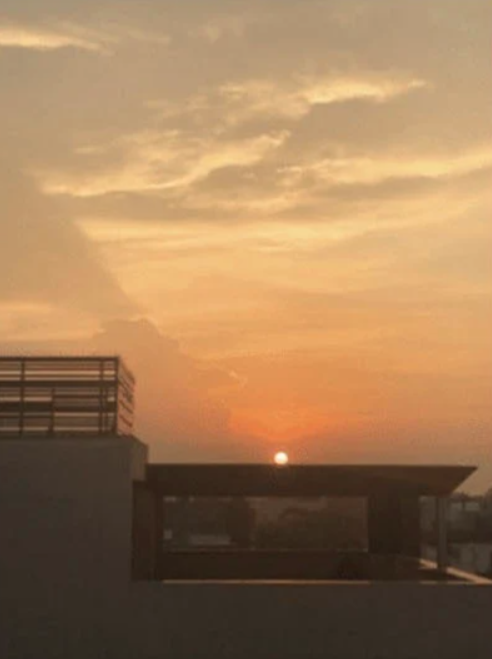
On December 1, 2021, Ankit Sahni sought registration from the Copyright Office in his work entitled SURYAST (“the Work”) and listed himself as the author of “photograph, 2-D artwork” and RAGHAV as the author of “2-D artwork,” with Mr. Sahni identified as the sole copyright claimant. In response to a request for more information on the AI used to create the work, Mr. Sahni explained that RAGHAV operates by taking two images—a “style image” and a “base image” to which the style will be applied—and a numerical value to indicate the amount or strength of the style transfer. The Board conceded Mr. Sahni’s “base photograph” is copyrightable, the question is whether the derivative “Starry Night-style” contains adequate copyrightable human creative expression.

When considering an application, the Office asks “[w]hether the ‘work’ is basically one of human authorship, with the computer or other device merely being an assisting instrument, or whether the traditional elements of authorship … (literary, artistic, or musical expression or elements of selection, arrangement, etc.) were actually conceived and executed not by man but by a machine.” Registration applications must disclose AI-generated content that is more than de minimis. If a work containing AI-generated material also contains sufficient human authorship to support a claim to copyright, then the Office will register the human’s contributions. Given these factors, the Office refused to register the Work because it contained insufficient human authorship, and Mr. Sahni’s contribution “cannot be distinguished or separated from the final work produced by the computer.”
Mr. Sahni ultimately submitted two requests for reconsideration. The Office denied the first request because the Work is a derivative digital adaptation of a photograph and because the new aspects of the Work were generated by RAGHAV, and not a human. On July 10, 2023, Mr. Sahni re-requested the Office to reconsider its determination, claiming his creative control resulted in the Work containing a sunset, clouds, the contours of a building, with the sky covering the upper two thirds of the work in the style of Van Gogh’s The Starry Night. The Board found that “the expressive elements … were not provided by Mr. Sahni.” Since Mr. Sahni merely provided three inputs to RAGHAV, the AI app was responsible for determining “how to interpolate the base and style images in accordance with the style transfer value.” Mr. Sahni did not control what elements would be placed where or the colors to be applied to them. Mr. Sahni’s selection of the style transfer strength numerical variable, alone, is insufficient for copyright protection.
Those seeking copyright protection over works that utilize AI should ensure that the human artist, not AI, controls the creative selection and arrangement elements of the work and that the human contribution of creative expression is more than de minimis while separately identifiable. However, because the Board stated that SURYAST is a derivative work, artists may be able to rely on copyright law’s protection of derivative works to prevent infringement of a derivative AI-generated artwork.
Irwin IP extends a heartfelt welcome to our newest senior attorney, Joseph Marinelli.

Joseph Marinelli has over 24 years of experience litigating complex patent, trade secret, trademark, and false advertising cases in a variety of industries including cellular communications protocols and standards, computer memory, datacenter cooling technologies, financial products and services, medical devices, and beverages.
Additionally, Joseph is skilled in counseling on intellectual property portfolio management and transactions, including structuring and negotiating IP licenses, joint ventures, and technology agreements. He has advised clients across a broad spectrum of technologies including liquid crystal displays, DRAM memory, lithium-ion batteries, medical devices, automotive components, polyethylene films, and data encryption systems. Furthermore, Joseph regularly counsels clients on patent infringement avoidance, which often involves providing validity opinions.
We look forward to Joseph making a strong impact in this new chapter with Irwin IP.
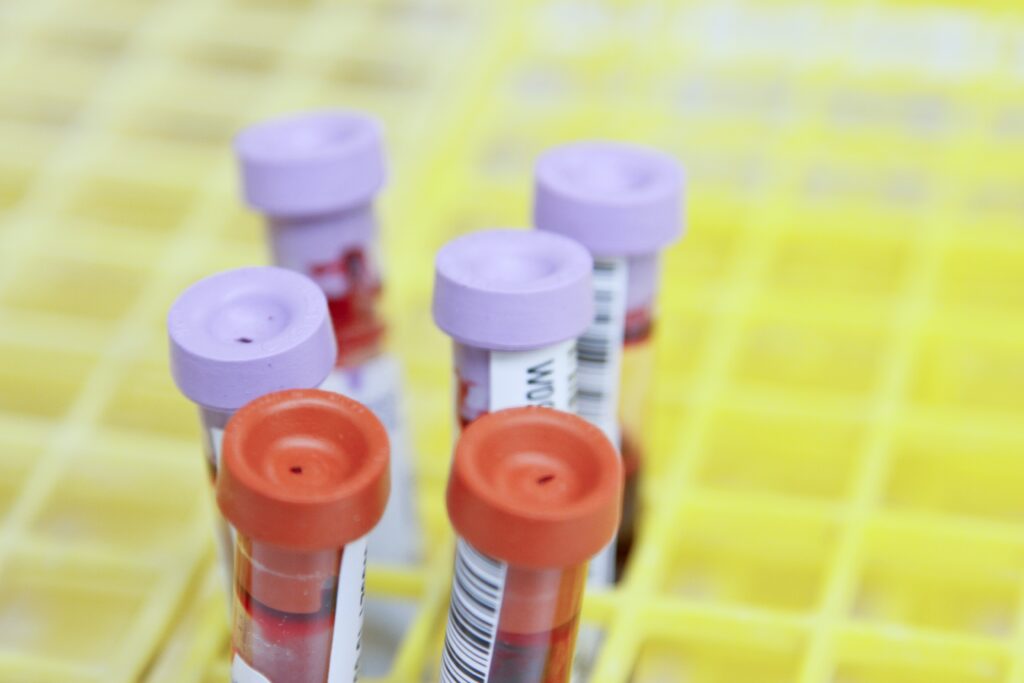
How should courts resolve patent infringement disputes where patients rely on allegedly infringing treatments? The U.S. District Court for the Middle District of North Carolina (the “Court”) recently grappled with this question in granting a preliminary injunction against NeoGenomics for their product “RaDaR,” in which allegedly infringes two of NeoGenomics’ competitor Natera’s patents: U.S. Patent Nos. 11,519035 (“the ‘035 patent”) and 11,530,454 (“the ‘454 patent”). The ‘035 patent and ‘454 patent are directed to methods for amplification of targeted genetic material, de-amplification of non-targeted genetic material, and the detection of targeted genetic material indicative of disease or disease recurrence. The patents were both granted in December 2022. RaDaR has been used in clinical cancer research since April 2020 and commercially available since March 2023. Natera sued NeoGenomics in July 2023 and sought a preliminary injunction against RaDaR.
The Court found that Natera had satisfied its burden to warrant a preliminary injunction. First, the Court found that Natera was likely to succeed on the merits of its infringement claim, expressly rejecting NeoGenomics’ invalidity arguments. The Court also found that because the presence of RaDaR would interfere with Natera’s ability arguments. The Court also found that because the presence of RaDaR would interfere with Natera’s ability to “establish brand recognition, customer loyalty, and business foundations [,]” Natera would suffer irreparable harm by allowing RaDaR to remain on the market. Further, the Court found that the balance of equities also favored granting of a preliminary injunction because Natera’s embodying product (“Signatera”) was important to Natera’s economic success and Natera’s “most valuable offering [,]” while RaDaR was only a small portion of NeoGenomics’ products.
But the Court’s analysis of the public interest factor required a more delicate approach. Here, the Court weighed Natera’s rights as a patent holder against the benefits of competition in the cancer diagnostics space and patients’ reliance on RaDaR for medical care. The Court found that although consumer choice is important, “competition from an infringing product does not benefit the public, and it impedes innovation.” But the Court also acknowledged the “public generally benefits from clinical trals, [product data, credibility in the marketplace, and published research so trials] should be carried out if they have been approved and completed if they are in process.” Particularly, as even Natera conceded, “current patients using RaDaR, whether in clinical trials or otherwise, cannot at this point in their medical care use Signatera as a substitute.” Accordingly, the Court ruled that while the preliminary injunction would stop commerical availability RaDaR, the preliminary injunction would also be “crafted” to “avoid[] disruption to ongoing treatment, research, and clinical studies [,]” which would include both ongoing trials and trials that have been approved, but not started.
The Court’s grant of a “partial” preliminary injunction demonstrates that certain scenarios, like in-progress or impending clinical trials, warrant exclusion from a preliminary injunction for public interest. The preliminary nature of the decision leaves open the question of how to deal with those patients relying on RaDaR should it ultimately be deemed infringing, since all parties agree that “avoiding disruption to ongoing treatment, research, and clinical studies is proper” regardless of the outcome in this case.
LKQ Corp. v. GM Global Technology Operations
The Federal Circuit is set to review a patent decision for the first time since 2018, potentially reshaping design patent law. The case involves LKQ, represented by Irwin IP, challenging GM design patents and arguing that current design patent tests conflict with the 2007 Supreme Court decision in KSR v. Teleflex. The Federal Circuit traditionally requires identifying an earlier design with the same visual impression and proving it would be obvious to modify, a test LKQ claims deviates the more flexible approach endorsed by KSR for utility patents. The en banc court will hear arguments on Feb. 5.
Read the full article at: Patent Cases To Watch In 2024 – Law360
*This article is located behind a paywall and is only available for viewing by those with a subscription to Law360.
Last year, Irwin IP underwent a transformative shift into a partnership, with Lisa Holubar, Mike Bregenzer, and Jason Keener joining Irwin IP’s founder Barry Irwin as partners. Since then, the firm has experienced sustained growth and remarkable success, solidifying its position as a leader in intellectual property litigation. We are delighted to announce effective January 1, 2024, this momentum continues with the addition of Joseph Saltiel being named as a Partner of the firm.

Joseph Saltiel joined Irwin IP in 2021 as a Senior Attorney, bringing with him an extensive background as an intellectual property litigator. With a proven track record of effectively advocating for clients in various courts nationwide, as well as before the USPTO and the ITC, Joseph specializes in IP litigation, counseling, and licensing. His expertise extends to clients beyond the United States, showcasing his adeptness in navigating international legal landscapes. While rooted in the electrical and computer arts, Joseph has successfully managed cases spanning diverse technologies, demonstrating quick proficiency in adapting to new and evolving technical fields. Furthermore, Joseph has earned the recognition as a “Leading Lawyer” for each of the last four years. This peer selected accolade is a testament to his exceptional legal skills and the high regard in which he is held within the legal community.
In addition to his role at Irwin IP, Joseph Saltiel is also an adjunct professor at the University of Illinois at Chicago School of Law. There, he imparts his knowledge by teaching classes on both patent law and trade secrets. This commitment to education underscores his dedication to contributing to the development of future legal professionals.
“I am extremely proud to have Joe join our partnership. Joe is an amazing attorney, and he has contributed significantly to the success of the firm,“ Barry Irwin commented regarding Joseph’s elevation to partner. “I look forward to working with Joe and the other partners at Irwin IP for the foreseeable future.”
Please join us in celebrating this significant achievement for Joseph Saltiel and his unwavering commitment to innovation, integrity, and having an impact in the legal community. We look forward to the growth and contributions of our dynamic team as we continue to navigate new horizons and further expand our impact.
——–
Irwin IP specializes in mission-critical intellectual property and technology litigation, catering to a diverse client base, including Fortune 500 companies and innovative startups. Our expertise extends to enforcing and protecting intellectual property portfolios, ensuring our clients’ product lines, worth hundreds of millions annually, remain secure. Notably, we routinely, successfully litigate against the largest, most prestigious law firms representing the largest companies in the world on matters valued in the tens and hundreds of millions.
Found a mistake in your patent? You might want to get it fixed at the U.S. Patent and Trademark Office (“PTO”). If the mistake is not corrected by the PTO, your patent may be found invalid in court. On December 14, 2023, the Southern District of Texas (“the court”) held all patent claims invalid because a claimed phrase contained an error that rendered the claims indefinite.
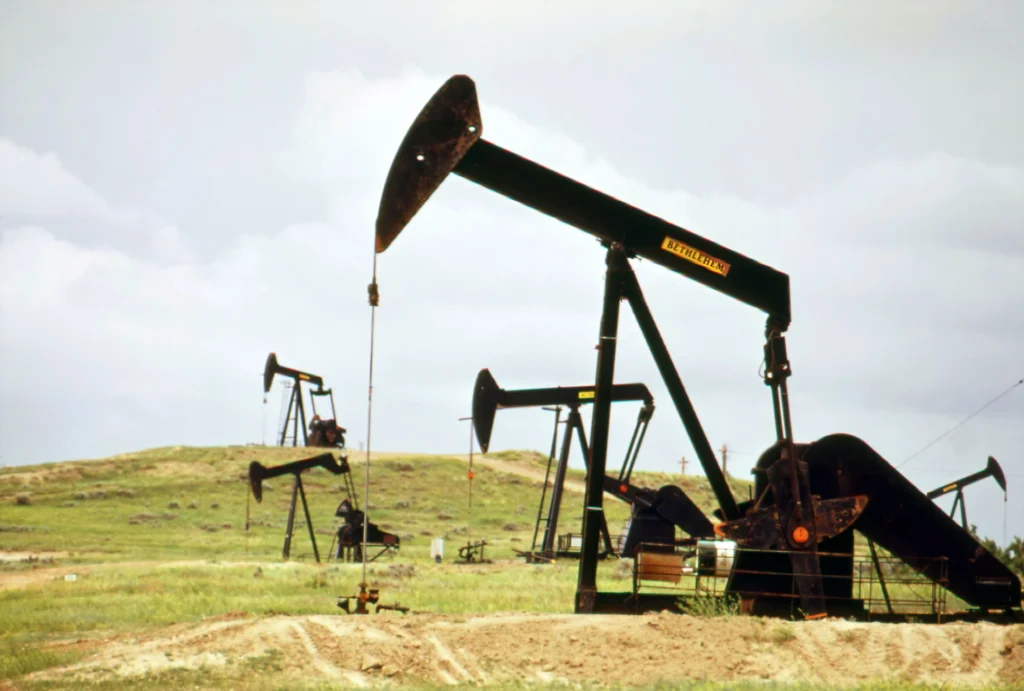
Canatex Completions Solutions, Inc. (“Canatex”) brought a patent infringement suit against Wellmatics, LLC (“Wellmatics”) asserting several claims from U.S. Patent No. 10,794,122 (“the ’122 Patent”). The claims of the ’122 patent generally relate to a “releasable connection for a downhole tool string” that is used in oil wells. The parties disputed five different claim phrases. In its December 14, 2023 claim construction order, the court analyzed the claim phrase “a release position that permits the releasable engagement profile to expand radially to release the connection profile of the second part.” Canatex stated this phrase contained an error but asked the court to fix it. Wellmatics argued the error was not evident on the face of the patent and asserted all of the claims were indefinite.
All of the independent claims in the ’122 patent included the phrase “the connection profile of the second part.” Notably, there was no antecedent basis for the “second part,” although there was an antecedent basis for the term “first part.” Canatex argued this was a clear clerical error. First, Canatex argued the use of the definite article “the” meant the phrase was referring back to the connection profile of the first part previously identified in the claim. Thus, a person of ordinary skill in the art (“POSITA”) would understand based on all the other references to a “connection profile” that the claims contained an error and that the drafters meant the connection profile of the first part. Second, Canatex argued that the specification’s use of the error indicated the drafter merely duplicated the error from the specification into the claims. In response, Wellmatics argued there was no antecedent basis for the connection profile of the second part, and that the error was not obvious because the patent describes both a first and second part, both of which have connection profiles. Therefore, Wellmatics argued a POSITA could not discern with reasonable certainty whether the claims referred to two connection profiles or only one. Additionally, Wellmatics argued because the specification used the same error, a POSITA would infer the phrase was intentional. The Court held the error was not evident from the face of the patent, and therefore the court could not “correct” the claim. Thus, all of the independent claims of the patent were invalid as indefinite. The fact that the error was found in the claims and specification suggested it was intentional. Additionally, the use of “the” instead of an “a” in the phrase suggested there could be multiple interpretations.
The court also rejected Canatex’s argument that the court should fix the error because the PTO would take too long to correct the error. The court again explained that while the PTO can correct non-obvious errors, courts can only correct mistakes that are evident on the face of the patent. Further, the court stated there was no case law that supported correcting an error in court when the PTO would take too long.
Patent owners should be careful when launching infringement suits if they think their claims may contain an error. If there is any uncertainty as to whether the error is evident from the face of the patent, the patent should be corrected through the PTO, even though it may take a long time. Otherwise, attempting to fix your claims through the court system runs the risk your claims may be found invalid as indefinite.
The Second Circuit was the first Circuit Court to address Jack Daniel’s Properties, Inc. v. VIP Products LLC, where the Supreme Court explained that when an alleged trademark infringer relies upon the goodwill of a trademark owner to market its own goods, the standard likelihood of confusion test applies even if the mark is used for an expressive purpose. In a per curium opinion, the Second Circuit held that no special First Amendment protections applied to protect MSCHF Production Studio (“MSCHF”) against trademark infringement claims by Vans, Inc. Instead, the likelihood of confusion test was appropriate despite a claim that the limited-edition sneaker was protected parody.
The Second Circuit first laid out the two legal tests. In assessing trademark infringement, courts generally use a multi-factored likelihood of confusion test. In the Second Circuit, courts use the “Polaroid” factors: (1) strength of the mark, (2) similarity of the marks, (3) proximity of the marks in the market, (4) likelihood the prior owner may “bridge the gap”, (5) actual confusion, (6) defendant’s good faith, or lack thereof, (7) product quality, and (8) consumer sophistication. However, when an accused product is a parody, courts have instead applied the so-called Rogers test. The Rogers test raises the bar for infringement, requiring the plaintiff to show the use of the trademark is not artistically relevant to the work or is explicitly misleading consumers as to the source for expressive works. Last June, the Supreme Court in Jack Daniels clarified that even if the accused infringer claims parody, the Rogers test does not apply if the alleged infringer uses the plaintiff’s mark for source identification, i.e. as a trademark.
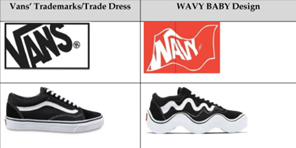
The Court then considered whether the use of trademarks and trade dress similar to Van’s should be evaluated under the Polaroid or Rogers test. Although distorted, MSCHF incorporated the Van’s black and white color scheme, the side stripe, the perforated sole, the logo on the heel, the logo on the footbed, and the packaging. Further, MSCHF did so without a disclaimer to disassociate the product from the plaintiff. These features, in addition to defendant’s admission that it started with the plaintiff’s mark in its design process, evidenced use in a source-identifying manner. After this determination, the Second Circuit applied the Polaroid test. Especially compelling was evidence of intent, actual confusion, and a similarity in terms of marketing: both MSCHF in this case and Van’s historically had partnered with artists to introduce limited edition shoes through similar channels of trade. The Court found the District Court’s conclusion to be correct and a preliminary injunction warranted.
Despite additional protections available under the Rogers test, the Second Circuit, who originally decided Rogers, made clear that companies should not expect an extra shield or to sidestep the likelihood of confusion factors by simply dubbing their goods a parody.
